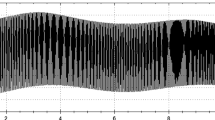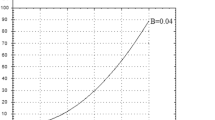Abstract
A developing approach for solving equations of a trapped motion of small satellite near the secondary planet mplanet (Earth) in case of the elliptic restricted problem of three bodies, ER3BP, is presented hereby. In ordinary way, this problem includes consideration of two primaries, MSun and mplanet (mplanet < < MSun), both are orbiting around their center of mass on Keplerian orbits. Eccentricity of orbit for the aforementioned mplanet is considered to be quasiperiodically variable depending on long-term Milankovitch cycles or various types of seasonal irradiation processes influencing onto orbit of planet (hereafter, Earth). Our aim is first to establish and second to investigate a novel type of ER3BP with variable eccentricity of secondary planet stemming from long-term Milankovitch cycles where in the formulation of above problem, small satellite will always maintain its orbit located near the secondary planet, mplanet. Indeed, Milankovitch cycles govern the dynamics of slow changing the eccentricity of the secondary planet orbit quasiperiodically during a long-time period of secondary planet’s motion around the primary. This planet moves on quasi-stable elliptic orbit with negligible deviations from purely elliptical motion. Semi-analytical solutions and numerical findings with graphical plots are presented accordingly.











Similar content being viewed by others
Change history
19 November 2022
A Correction to this paper has been published: https://doi.org/10.1007/s00419-022-02328-6
References
Ershkov, S., Aboeulmagd, E., Rachinskaya, A.: A novel type of ER3BP introduced for hierarchical configuration with variable angular momentum of secondary planet. Arch. Appl. Mech. 91(11), 4599–4607 (2021)
Arnold, V.: Mathematical Methods of Classical Mechanics. Springer, New York (1978)
Lagrange J.: 'OEuvres' (M.J.A. Serret, Ed.). Vol. 6, published by Gautier-Villars, Paris. (1873)
Duboshin G.N.: Nebesnaja mehanika. Osnovnye zadachi i metody. Moscow: “Nauka” (handbook for Celestial Mechanics, in russian). (1968)
Szebehely V.: Theory of Orbits. The Restricted Problem of Three Bodies. Yale University, New Haven, Connecticut. Academic Press New-York and London. (1967)
Ferrari, F., Lavagna, M.: Periodic motion around libration points in the Elliptic restricted three-body problem. Nonlinear Dyn. 93(2), 453–462 (2018)
Llibre, J., Conxita, P.: On the elliptic restricted three-body problem. Celest. Mech. Dyn. Astron. 48(4), 319–345 (1990)
Ershkov, S., Rachinskaya, A.: Semi-analytical solution for the trapped orbits of satellite near the planet in ER3BP. Arch. Appl. Mech. 91(4), 1407–1422 (2021)
Ershkov, S., Leshchenko, D., Rachinskaya, A.: Note on the trapped motion in ER3BP at the vicinity of barycenter. Arch. Appl. Mech. 91(3), 997–1005 (2021)
Abouelmagd, E.I.: Stability of the triangular points under combined effects of radiation and oblateness in the restricted three-body problem. Earth Moon Planet 110(3), 143–155 (2013)
Ershkov, S., Leshchenko, D., Aboeulmagd, E.: About influence of differential rotation in convection zone of gaseous or fluid giant planet (Uranus) onto the parameters of orbits of satellites. Eur. Phys. J. Plus 136, 387 (2021)
Ershkov, S.V.: About tidal evolution of quasi-periodic orbits of satellites. Earth Moon Planet. 120(1), 15–30 (2017)
Milankovitch M.: Mathematische Klimalehre und Astronomische Theorie der Klimaschwankungen. Handbuch der Klimatologie. Publisher: Borntraeger, Berlin. (1930)
Ershkov, S.V., Leshchenko, D.: Revisiting Apophis 2029 approach to Earth (staying on shoulders of NASA’s experts) or Can we be sure in almost ricocheting fly-by of Apophis on 13 of April 2029 near the Earth? J. Space Saf. Eng. 9(3), 363–1374 (2022)
Ershkov, S., Leshchenko, D., Rachinskaya, A.: Revisiting the dynamics of finite-sized satellite near the planet in ER3BP. Arch. Appl. Mech. 92(8), 2397–2407 (2022)
Ershkov, S., Leshchenko, D., Rachinskaya, A.: Capture in regime of a trapped motion with further inelastic collision for finite-sized asteroid in ER3BP. Symmetry 14(8), 1548 (2022)
Ferraz-Mello, S., Rodríguez, A., Hussmann, H.: Tidal friction in close-in satellites and exoplanets: The Darwin theory re-visited. Celest. Mech. Dyn. Astron. 101, 171–201 (2008). https://doi.org/10.1007/s10569-008-9133-x
Sidorenko, V.V.: The eccentric Kozai-Lidov effect as a resonance phenomenon. Celest. Mech. Dyn. Astron. 130(1), 4 (2018)
Singh, J., Umar, A.: On motion around the collinear libration points in the elliptic R3BP with a bigger triaxial primary. New Astron. 29, 36–41 (2014)
Zotos, E.E.: Crash test for the Copenhagen problem with oblateness. Celest. Mech. Dyn. Astron. 122(1), 75–99 (2015)
Abouelmagd, E.I., Sharaf, M.A.: The motion around the libration points in the restricted three-body problem with the effect of radiation and oblateness. Astrophys. Space Sci. 344(2), 321–332 (2013)
Kushvah, B.S., Sharma, J.P., Ishwar, B.: Nonlinear stability in the generalised photogravitational restricted three body problem with Poynting-Robertson drag. Astrophys. Space Sci. 312(3–4), 279–293 (2007)
Nekhoroshev, N.N.: Exponential estimate on the stability time of near integrable Hamiltonian systems. Russ. Math. Surv. 32(6), 1–65 (1977)
Lidov, M.L., Vashkov’yak, M.A.: Theory of perturbations and analysis of the evolution of quasi-satellite orbits in the restricted three-body problem. Kosmicheskie Issledovaniia 31, 75–99 (1993)
Peale, S.J.: Orbital resonances in the solar system. Ann. Rev. Astron. Astrophys. 14, 215–246 (1976)
Wiegert, P., Innanen, K., Mikkola, S.: The stability of quasi satellites in the outer solar system. Astron. J. 119, 1978–1984 (2000). https://doi.org/10.1086/301291
Lhotka C.: Nekhoroshev stability in the elliptic restricted three body problem. Thesis for: Doktor rerum naturalium. DOI: https://doi.org/10.13140/RG.2.1.2101.3848. (2008)
Berger, A., Loutre, M.-F., Tricot, Ch.: Insolation and Earth’s orbital periods. J. Geophys. Res. 98(D6), 10341–10362 (1993)
Ershkov, S., Leshchenko, D., Rachinskaya, A.: Semi-analytical findings for rotational trapped motion of satellite in the vicinity of collinear points L1, L2 in planar ER3BP. Arch. Appl. Mech. 92(10), 3005–3012 (2022)
Melnikov, A.V.: Rotational dynamics of asteroids approaching planets. Sol. Syst. Res. 56, 241–251 (2022)
Ershkov, S., Leshchenko, D.: Analysis of the size of Solar system close to the state with zero total angular momentum via Sundman’s inequality. Anais da Academia Brasileira de Ciências 93(Suppl. 3), e20200269 (2021)
Ershkov, S., Leshchenko, D.: Estimation of the size of the solar system and its spatial dynamics using Sundman inequality. Pramana J. Phys. 96, 158 (2022)
Ershkov, S., Leshchenko, D.: On the stability of Laplace resonance for Galilean moons (Io, Europa, Ganymede). Ann. Braz. Acad. Sci. 93(4), e20201016 (2021)
Abouelmagd, E.I., Ansari, A.A.: The motion properties of the infinitesimal body in the framework of bicircular Sun perturbed Earth-Moon system. New Astron. 73, 101282 (2019)
Zotos, E.E., Chen, W., Abouelmagd, E.I., Han, H.: Basins of convergence of equilibrium points in the restricted three-body problem with modified gravitational potential. Chaos Solitons Fractals 134, 109704 (2020)
Alshaery, A.A., Abouelmagd, E.I.: Analysis of the spatial quantized three-body problem. Results Phys. 17, 103067 (2020)
Abozaid, A.A., Selim, H.H., Gadallah, K.A., Hassan, I.A., Abouelmagd, E.I.: Periodic orbit in the frame work of restricted three bodies under the asteroids belt effect. Appl. Math. Nonlinear Sci. 5(2), 157–176 (2020)
Abouelmagd, E.I., Mostafa, A., Guirao, J.L.G.: A first order automated Lie transform. Int. J. Bifurc. Chaos 25(14), 1540026 (2015)
Abouelmagd, E.I., Pal, A.K., Guirao, J.L.: Analysis of nominal halo orbits in the Sun-Earth system. Arch. Appl. Mech. 91(12), 4751–4763 (2021)
Ershkov, S.V., Leshchenko, D.: Revisiting dynamics of Sun center relative to barycenter of Solar system or Can we move towards stars using Solar self-resulting photo-gravitational force? J. Space Saf. Eng. 9(2), 160–164 (2022)
Ershkov, S.V.: Forbidden zones for circular regular orbits of the moons in solar system, R3BP. J. Astrophys. Astron. 38(1), 1–4 (2017)
Author information
Authors and Affiliations
Contributions
In this research, Dr. S.E. is responsible for the general ansatz and the solving procedure, simple algebra manipulations, calculations, results of the article and also is responsible for the search for analytical and semi-analytical solutions. Dr. D.L. is responsible for theoretical investigations as well as for the deep survey of the literature on the problem under consideration. Dr. E.P. is responsible for obtaining numerical solutions related to approximated ones (including their graphical plots). All authors agreed with results and conclusions of each other in Sects. 1–4.
Corresponding author
Ethics declarations
Conflict of interest
On behalf of all authors, the corresponding author states that there is no conflict of interest.
Additional information
Publisher's Note
Springer Nature remains neutral with regard to jurisdictional claims in published maps and institutional affiliations.
Rights and permissions
Springer Nature or its licensor (e.g. a society or other partner) holds exclusive rights to this article under a publishing agreement with the author(s) or other rightsholder(s); author self-archiving of the accepted manuscript version of this article is solely governed by the terms of such publishing agreement and applicable law.
About this article
Cite this article
Ershkov, S., Leshchenko, D. & Prosviryakov, E.Y. A novel type of ER3BP introducing Milankovitch cycles or seasonal irradiation processes influencing onto orbit of planet. Arch Appl Mech 93, 813–822 (2023). https://doi.org/10.1007/s00419-022-02300-4
Received:
Accepted:
Published:
Issue Date:
DOI: https://doi.org/10.1007/s00419-022-02300-4




